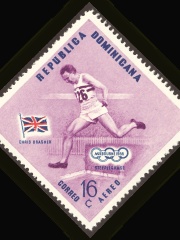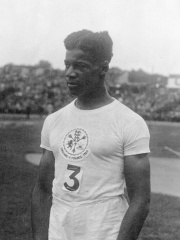



The Most Famous
ATHLETES from Guyana
Top 4
The following people are considered by Pantheon to be the most legendary Guyanese Athletes of all time. This list of famous Guyanese Athletes is sorted by HPI (Historical Popularity Index), a metric that aggregates information on a biography’s online popularity.

1. Chris Brasher (1928 - 2003)
With an HPI of 38.82, Chris Brasher is the most famous Guyanese Athlete. Her biography has been translated into 20 different languages on wikipedia.
Christopher William Brasher CBE (21 August 1928 – 28 February 2003) was a British track and field athlete, sports journalist and co-founder of the London Marathon.

2. Mark McKoy (b. 1961)
With an HPI of 38.66, Mark McKoy is the 2nd most famous Guyanese Athlete. His biography has been translated into 22 different languages.
Mark Anthony McKoy (born December 10, 1961) is a Canadian retired track and field athlete. He won the gold medal in the 110 metres hurdles at the 1992 Barcelona Olympics. He also won the 60 metres hurdles title at the 1993 IAAF World Indoor Championships, and the 110 metres hurdles titles at the Commonwealth Games in 1982 and 1986. He is the World record holder for the 50 metres hurdles with 6.25 secs (1986), and the Canadian record holder in the 60 metres hurdles with 7.41 secs (1993), and the 110 metres hurdles with 13.08 secs (1993).

3. Jack London (1905 - 1966)
With an HPI of 38.49, Jack London is the 3rd most famous Guyanese Athlete. His biography has been translated into 15 different languages.
John Edward London (13 January 1905 – 2 May 1966) was a British athlete who competed mainly in the 100 metres. Born in British Guiana, now Guyana, he won a silver and a bronze medal at the 1928 Summer Olympics in Amsterdam. He moved to London as a child. At some point his family moved back to British Guiana, where London attended Queen's College in Georgetown. Back in England, London studied at the Regent Street Polytechnic, where he joined the Polytechnic Harriers and was coached by Sam Mussabini. He was elected captain of the sports club in October 1922. He was an early adopter of starting blocks rather than digging footholds in the cinder tracks. He ran the 100 metres in 10.7 seconds to win the race at a competition between England and France at Stamford Bridge in July 1927, and then won both the 100 metres and the 200 metres at a competition in Paris in October 1927. London competed for Great Britain in the 1928 Summer Olympics held in Amsterdam, Netherlands. After equalling the Olympic 100 metres record of 10.6 seconds in the semi-final, he won the silver medal in the 100 metres final, behind Canadian Percy Williams. He then won the bronze medal in the 4×100 metres relay with his teammates Cyril Gill, Edward Smouha and Walter Rangeley, behind the teams of the US and Germany. He was the first to use starting blocks at the Olympic Games. He was awarded the Polytechnic Harriers's S. A. Mussabini memorial medal (Mussabini having died in 1927) and the Studd Trophy in 1928. He was later coached by Albert Hill. In July 1929, he became the first British sprinter to win the Amateur Athletic Association's 100 yards title since Harold Abrahams in 1924. He was also a leading British high jumper in this period. His athletic career was curtailed by a leg injury in 1930. He joined a 4×100 metre relay for England against Germany in 1931, but was not selected for the 1932 Summer Olympics in Los Angeles. After he retired from athletics, he became an entertainer, playing piano in the original cast of the Noël Coward's musical Cavalcade at the Theatre Royal, Drury Lane in 1931. He also appeared in Will Hay's Gainsborough Pictures comedy Old Bones of the River in 1938. He married at Marylebone register office in 1930, where his profession was recorded as "pianist". He was later divorced and remarried in 1938. With athletics journalist Joe Binks, he co-wrote an athletics coaching manual in 1948, The Way to Win on Track and Field, but the book was not a commercial success. He later worked as a porter at St Pancras Hospital, and died suddenly from a subarachnoid haemorrhage.

4. Phil Edwards (1907 - 1971)
With an HPI of 37.69, Phil Edwards is the 4th most famous Guyanese Athlete. His biography has been translated into 16 different languages.
Philip Aaron Edwards, MD (September 23, 1907 – September 6, 1971) was a Canadian and Guyanese track and field athlete who competed in middle-distance events. Nicknamed the "Man of Bronze", he was Canada's most-decorated Olympian for many years. He was the first-ever winner of the Lou Marsh Trophy as Canada's top athlete. He went on to serve as a captain in the Canadian army and as a highly regarded physician and expert of tropical diseases.
People
Pantheon has 4 people classified as Guyanese athletes born between 1905 and 1961. Of these 4, 1 (25.00%) of them are still alive today. The most famous living Guyanese athletes include Mark McKoy. The most famous deceased Guyanese athletes include Chris Brasher, Jack London, and Phil Edwards. As of April 2024, 1 new Guyanese athletes have been added to Pantheon including Jack London.
Living Guyanese Athletes
Go to all RankingsDeceased Guyanese Athletes
Go to all RankingsNewly Added Guyanese Athletes (2024)
Go to all RankingsOverlapping Lives
Which Athletes were alive at the same time? This visualization shows the lifespans of the 3 most globally memorable Athletes since 1700.

